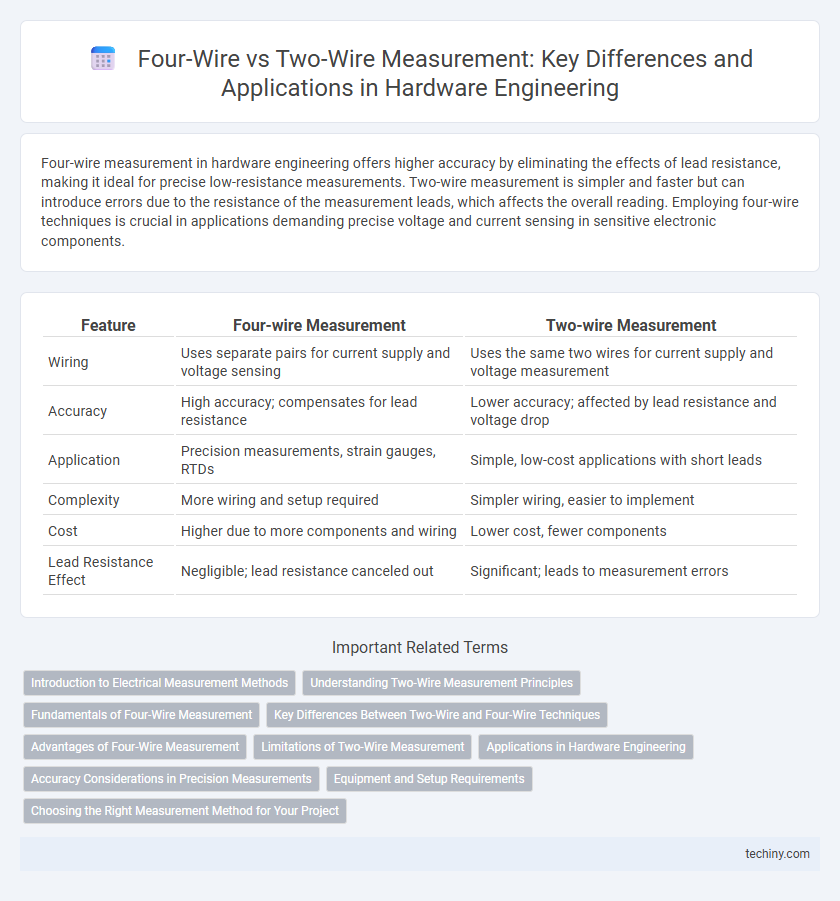Four-wire measurement in hardware engineering offers higher accuracy by eliminating the effects of lead resistance, making it ideal for precise low-resistance measurements. Two-wire measurement is simpler and faster but can introduce errors due to the resistance of the measurement leads, which affects the overall reading. Employing four-wire techniques is crucial in applications demanding precise voltage and current sensing in sensitive electronic components.
Table of Comparison
| Feature | Four-wire Measurement | Two-wire Measurement |
|---|---|---|
| Wiring | Uses separate pairs for current supply and voltage sensing | Uses the same two wires for current supply and voltage measurement |
| Accuracy | High accuracy; compensates for lead resistance | Lower accuracy; affected by lead resistance and voltage drop |
| Application | Precision measurements, strain gauges, RTDs | Simple, low-cost applications with short leads |
| Complexity | More wiring and setup required | Simpler wiring, easier to implement |
| Cost | Higher due to more components and wiring | Lower cost, fewer components |
| Lead Resistance Effect | Negligible; lead resistance canceled out | Significant; leads to measurement errors |
Introduction to Electrical Measurement Methods
Four-wire measurement technique significantly reduces the effect of lead resistance by using separate pairs of wires for current supply and voltage sensing, ensuring higher accuracy in low-resistance electrical measurements. Two-wire measurement combines current and voltage paths in the same wires, which can introduce measurement errors due to voltage drops along the lead wires. In hardware engineering, precise electrical measurement methods like four-wire sensing are crucial for characterizing components such as resistors, sensors, and circuit boards where accurate resistance values impact device performance.
Understanding Two-Wire Measurement Principles
Two-wire measurement uses a single pair of wires to both power and sense the electrical signal, causing lead resistance to affect the accuracy of voltage or current readings. This method is simpler and cost-effective but introduces measurement errors, especially in low-resistance applications where the voltage drop across the leads is significant. Understanding the limitations of two-wire measurement is crucial for hardware engineers when designing circuits that require precise resistance or voltage measurements.
Fundamentals of Four-Wire Measurement
Four-wire measurement significantly improves accuracy by eliminating lead and contact resistance from voltage measurements in hardware engineering. This technique uses separate pairs of wires for current supply and voltage sensing, ensuring that voltage drops due to lead resistance do not affect the measured value. As a result, four-wire measurement is essential for precise low-resistance measurements and is widely applied in sensor calibration and high-precision component testing.
Key Differences Between Two-Wire and Four-Wire Techniques
Two-wire measurement uses the same pair of leads for current supply and voltage measurement, leading to potential errors due to lead resistance affecting accuracy. Four-wire measurement separates the current and voltage paths with dedicated pairs of leads, minimizing the impact of lead and contact resistance on the measured voltage. This technique is critical in precision hardware engineering applications where highly accurate resistance or voltage readings are required.
Advantages of Four-Wire Measurement
Four-wire measurement significantly improves accuracy by eliminating the influence of lead and contact resistance, making it ideal for precise low-resistance measurements. This method uses separate pairs of current-carrying and voltage-sensing wires, ensuring that voltage drop due to lead resistance does not affect the measurement. It is especially advantageous in hardware engineering applications where precision and reliability in sensing minute resistance changes are critical.
Limitations of Two-Wire Measurement
Two-wire measurement in hardware engineering often suffers from inaccuracies due to the inclusion of lead resistance, which can introduce significant voltage drops and affect the precision of low-resistance sensing. This method is limited in applications requiring high accuracy because wiring resistance changes with temperature and length, causing measurement errors. Advanced systems prefer four-wire measurement techniques to eliminate lead resistance effects and improve the reliability of electrical parameter readings.
Applications in Hardware Engineering
Four-wire measurement is essential in hardware engineering when precise resistance readings are critical, such as in sensing low-resistance components or PCB trace characterization, because it eliminates lead and contact resistance errors. Two-wire measurement suits simpler applications where precision is less critical, like basic continuity tests or high-resistance components, due to its simpler setup and fewer terminals. Engineers select four-wire methods for high-accuracy testing in device fabrication, calibration, and quality assurance processes.
Accuracy Considerations in Precision Measurements
Four-wire measurement significantly improves accuracy in precision measurements by eliminating the effects of lead and contact resistances, which can introduce errors in two-wire configurations. In two-wire measurement, the same pair of wires carries both current and voltage signals, causing the measured voltage to include the resistance of the leads, thus reducing measurement precision. Implementing four-wire measurement techniques with separate pairs for current supply and voltage sensing ensures high fidelity in resistance and low-level signal measurements critical in hardware engineering.
Equipment and Setup Requirements
Four-wire measurement requires specialized equipment with separate pairs of leads for current supply and voltage sensing, significantly reducing the effects of lead and contact resistance. Two-wire measurement uses simpler setups with a single pair of leads for both current and voltage, often leading to less accuracy in low-resistance measurements. Accurate four-wire setups typically involve precision current sources and high-impedance voltmeters to ensure precise resistance readings in hardware engineering applications.
Choosing the Right Measurement Method for Your Project
Selecting between four-wire and two-wire measurement methods depends on the required accuracy and the wiring complexity of the hardware project. Four-wire measurements eliminate lead resistance effects, providing highly precise readings essential for low-resistance components and sensitive sensors. Two-wire measurements offer simplicity and cost-effectiveness, suitable for general applications where minor resistance errors do not impact the overall performance.
Four-wire vs Two-wire measurement Infographic

 techiny.com
techiny.com